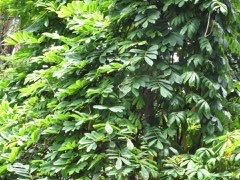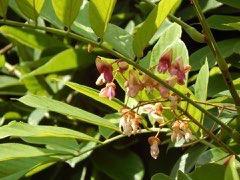 |
|
Forest and Kim Starr flickr.com |
 |
| Forest and Kim Starr flickr.com |
Translate this page:
Summary
Derris, Paraderris elliptica, is an evergreen climbing shrub with woody stems that grow up to 16m long and commonly found in East Asia. There is no known edible uses of Derris but it has several medicinal uses. It is used traditionally to eliminate microorganisms that cause diseases. It is applied to abscesses and used in the treatment of leprosy. It is sometimes used to cause abortion and increase menstrual flow in women. The root contains a toxic substance known as Rotenone, which is used as an insecticide.
Physical Characteristics

 Paraderris elliptica is a CLIMBER growing to 16 m (52ft) by 2 m (6ft) at a medium rate.
Paraderris elliptica is a CLIMBER growing to 16 m (52ft) by 2 m (6ft) at a medium rate.
See above for USDA hardiness. It is hardy to UK zone 10.
Suitable for: light (sandy), medium (loamy) and heavy (clay) soils and prefers well-drained soil. Suitable pH: mildly acid, neutral and basic (mildly alkaline) soils. It can grow in semi-shade (light woodland) or no shade. It prefers moist soil.
UK Hardiness Map
US Hardiness Map
Synonyms
Deguelia elliptica (Roxb.) Taub. Derris elliptica (Wall.) Benth. Galedupa elliptica Roxb. Pongamia d
Plant Habitats
Edible Uses
References More on Edible Uses
Medicinal Uses
Plants For A Future can not take any responsibility for any adverse effects from the use of plants. Always seek advice from a professional before using a plant medicinally.
Abortifacient Antiseptic Antitumor Blood tonic Emmenagogue Leprosy Parasiticide
The plant is traditionally used for antisepsis and is applied to abscesses and against leprosy and itch, and sometimes as an abortifacient[303 ]. The roots are used as emmenagogue[303 ]. The stems are a blood tonic[303 ]. Rotenone, the active insecticidal ingredient found mainly in the root, has been evaluated as a potential antitumor agent[303 ]. It is broadly cytotoxic, the growth-inhibiting effect has been demonstrated both with cultured cells and experimental tumours[303 ]. The roots also contain tubaic acid (0.01% of air-dried root). This compound has shown anti-microbial activity, inhibiting the growth of Bacillus subtilis, Staphylococcus aureus and Escherichia coli at high concentrations[303 ].
References More on Medicinal Uses
The Bookshop: Edible Plant Books
Our Latest books on Perennial Plants For Food Forests and Permaculture Gardens in paperback or digital formats.

Edible Tropical Plants
Food Forest Plants for Hotter Conditions: 250+ Plants For Tropical Food Forests & Permaculture Gardens.
More

Edible Temperate Plants
Plants for Your Food Forest: 500 Plants for Temperate Food Forests & Permaculture Gardens.
More

More Books
PFAF have eight books available in paperback and digital formats. Browse the shop for more information.
Shop Now
Other Uses
Insecticide Parasiticide
The powdered root is widely used as an insecticide[303 ]. It is effective against a range of horticultural pests, such as aphids and caterpillars, and also against external body parasites like ticks, lice, fleas and flies[418 ]. The root can be up to 2cm in diameter and more than 2 metres long[418 ].
Special Uses
Food Forest
References More on Other Uses
Cultivation details
A plant mainly found in humid, lowland tropical areas, though it can also be grown at elevations up to 1,500 metres. It grows best in areas where annual daytime temperatures are within the range 24 - 30°c, but can tolerate 20 - 36°c[418 ]. It prefers a mean annual rainfall in the range 1,800 - 3,500mm, but tolerates 1,400 - 5,000mm[418 ]. It can survive dry periods of up to 4 months[418 ]. Prefers a position in full sun or in light shade[418 ]. Succeeds in most well-drained soils of at least moderate fertility[418 ]. Prefers a pH in the range 5.5 - 7, tolerating 4.3 - 8.6[418 ]. Plants can commence flowering when about 18 months old[303 ]. The yield of dried roots is 1,100 - 1,800 kg/ha, occasionally up to 3,000 kg/ha, particularly when plants are trellised[303 ]. There is a danger of soil erosion during the first few months after planting and again after harvesting, therefore land suitable for this crop should either be flat or only slightly sloping[418 ]. Several cultivars (mostly clones of this vegetatively propagated crop) are widespread in cultivation and have bean selected for high rotenone content (13% of the roots)[317 ].
References Carbon Farming Information and Carbon Sequestration Information
Temperature Converter
Type a value in the Celsius field to convert the value to Fahrenheit:
Fahrenheit:
The PFAF Bookshop
Plants For A Future have a number of books available in paperback and digital form. Book titles include Edible Plants, Edible Perennials, Edible Trees,Edible Shrubs, Woodland Gardening, and Temperate Food Forest Plants. Our new book is Food Forest Plants For Hotter Conditions (Tropical and Sub-Tropical).
Shop Now
Plant Propagation
Seed -
Other Names
If available other names are mentioned here
Derris
Native Range
TROPICAL ASIA: Bangladesh, India, Assam, Meghalaya, Odisha, Punjab, Tamil Nadu, West Bengal, Nepal, India, Andaman and Nicobar Islands, Cambodia, Laos, Myanmar, Thailand, Malaysia, Philippines,
Weed Potential
Right plant wrong place. We are currently updating this section.
Please note that a plant may be invasive in one area but may not in your area so it's worth checking.
Conservation Status
IUCN Red List of Threatened Plants Status : This taxon has not yet been assessed

Growth: S = slow M = medium F = fast. Soil: L = light (sandy) M = medium H = heavy (clay). pH: A = acid N = neutral B = basic (alkaline). Shade: F = full shade S = semi-shade N = no shade. Moisture: D = dry M = Moist We = wet Wa = water.
Now available:
Food Forest Plants for Mediterranean Conditions
350+ Perennial Plants For Mediterranean and Drier Food Forests and Permaculture Gardens.
[Paperback and eBook]
This is the third in Plants For A Future's series of plant guides for food forests tailored to
specific climate zones. Following volumes on temperate and tropical ecosystems, this book focuses
on species suited to Mediterranean conditions—regions with hot, dry summers and cool, wet winters,
often facing the added challenge of climate change.
Read More
Expert comment
Author
(Wall.) Adema
Botanical References
Links / References
For a list of references used on this page please go here
A special thanks to Ken Fern for some of the information used on this page.
Readers comment
| Add a comment |
|
If you have important information about this plant that may help other users please add a comment or link below. Only comments or links that are felt to be directly relevant to a plant will be included. If you think a comment/link or information contained on this page is inaccurate or misleading we would welcome your feedback at [email protected]. If you have questions about a plant please use the Forum on this website as we do not have the resources to answer questions ourselves.
* Please note: the comments by website users are not necessarily those held by PFAF and may give misleading or inaccurate information.
To leave a comment please Register or login here All comments need to be approved so will not appear immediately.
|
Subject : Paraderris elliptica
|
|
|
|